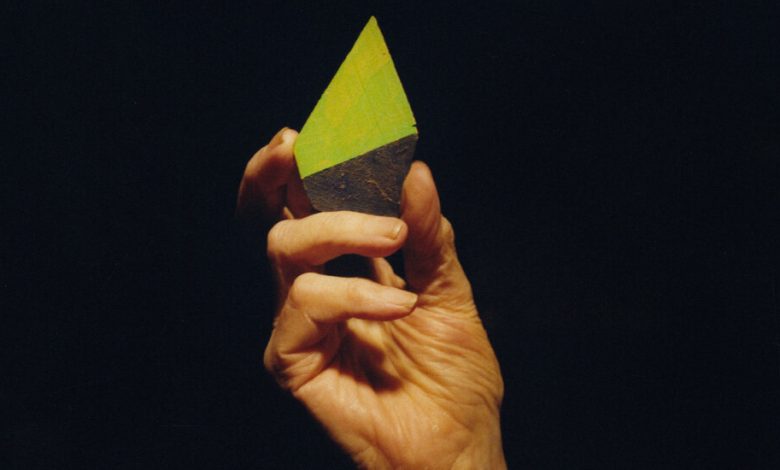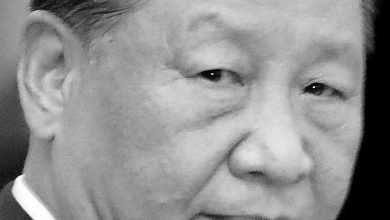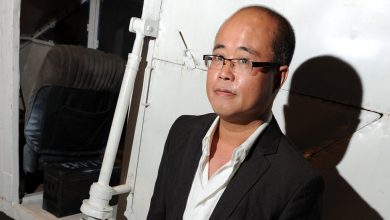Sculptures That Don’t Have to Add Up to Work Like Magic

The wooden objects Hans Noë constructs — columns, walls and confounding clumps of simple but unusual geometric solids — aren’t exactly sculpture. They’re not quite high design, either, or children’s toys, or math problems, or architectural maquettes. But they could almost fit in any of these categories, evoking forebears and influences as various as Constantin Brancusi, Ludwig Mies van der Rohe and Friedrich Froebel. And at the National Museum of Mathematics right now, the writer Lawrence Weschler, a friend of Noë’s son Alva, has brought four dozen of them together in the exhibition “Hans Noë — Sculpture.”
Noë’s background may offer some explanation for the ambiguity of his work. He was born to Austrian Jewish parents in Czernowitz (now Chernivtsi, Ukraine), an area that changed hands repeatedly. Noë’s family survived World War II thanks to luck, ingenuity and his father’s reputation as a pediatrician.

“The Romanians who occupied us,” Noë observed, “also had children.” When the fighting finally ended, the family fled to Germany, where Noë studied with the type designer Herman Zapf, then to New York, where he attended Cooper Union and found a mentor in the architect and sculptor Tony Smith.

Hans Noë, architect, accidental real estate developer, reviver of Fanelli Cafe and constructor of mathematical objects, at his home in Garrison, N.Y.Credit…Alex Hodor-Lee for The New York Times
He studied with Mies van der Rohe in Illinois, too. But though he did eventually work as an architect, most notably building a series of modest but spacious houses in the Hamptons, he mainly made his living in real estate. To get himself work spaces, he bought and renovated dilapidated buildings, including one in SoHo that came with New York’s second-oldest bar, Fanelli Cafe. That was in the early 1980s; he spent the next two decades as an obsessive restaurateur before handing off management to his son Sasha.
Through the years, Weschler says, Noë would often wake up with half-formed geometric ideas in his mind, ideas that he rendered in cardboard or wood, painted, and set aside. Many were made by stacking up a geometric shape he first hit upon when presenting a proposal (ultimately unsuccessful) for a United Nations building being planned for Rome in the 1950s.

Imagine a plus sign made of two perpendicular rectangles superimposed. Now lift one rectangle straight up, draw a line from each of its corners to the corresponding corner on the lower rectangle, and pretend the whole figure is a solid block of wood. You’ve just made a squished not-quite-cube with two rectangular sides joined by four trapezoids. The magic of this shape, which Noë calls a “truncated tetrahedron,” is that it can seem, depending on your point of view, to be leaning over or to be perfectly still, to be almost a pyramid as well as almost a cube.




A crumpled arch, a writhing tower, and a staircase that can be endlessly rearranged are among the untitled pieces in “Hans Noë — Sculpture.”Credit…Alex Hodor-Lee for The New York Times
Stack seven of them, with rectangular faces aligned, and you get a gracefully serrated, eight-foot-high tower very much like Brancusi’s “Endless Column.” At least, it’s very much like the Brancusi from certain angles. Step a few feet over and suddenly the same column looks like a rectangular plank, its edges nearly straight, its face marked with a curious, zigzag pattern of triangular shadows that don’t quite add up. Arrange the rectangular faces perpendicularly instead, and you get a rhythmic, angled, saw-toothed shape rising slowly from the floor like an inverted staircase.
Noë performs a similar trick with triangles. If you start with a Star of David made of two equilateral triangles, one on top of the other; lift one up again; and draw twolines from each of its points to the nearest points of the triangle below, you get an extended prism-like solid that seems to be falling in every direction at once. Paint three of these prisms red, pile them up in a column, and mount the results on a turntable, and you have a hypothetical skyscraper that seems to twist and writhe as it rotates.
Though Weschler chose only a small, recent sample of the pieces Noë has made over the decades, the show has undeniable range. There are loops and curls of triangular yellow struts, notched black cubes that call to mind Noguchi, mobiles of intersecting cardboard pyramids, a crumpled orange arch and one large cube cut into elegant step-like slices that can be rearranged, as an accompanying video demonstrates, more or less infinitely. Here and there Noë has placed little paper people to give an alternate sense of scale. You can see just how dramatic any of his pieces would be as public sculpture.
In another sense, though, every piece is a variation on a single idea, one intuitive, Euclidean leap. Or maybe a philosophical one. Noë has figured out how to illustrate, with geometric metaphors, a truth about life so basic that it’s almost cliché, but which remains impossible for most of us to really grasp — that you can never actually know what’s coming around the corner. What looks like one thing turns out to be another; what seems utterly dependable may be on the cusp of falling down; and what looks as if it’s falling down might just last longer than you do.
Sculpture: The Work of Hans Noë
Through Oct. 31 at the National Museum of Mathematics, 11 East 26th Street, Manhattan; 212-542-0566, momath.org.




